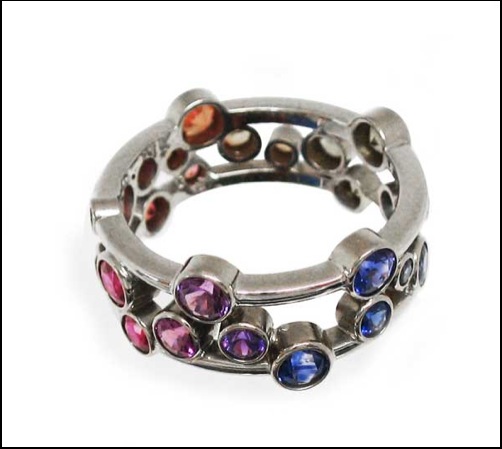Check out our Sapphire board on Pinterest for more photos and info!

Tom Dailing’s “Bubble Ring” shows the many colors of sapphire.
Sapphire
Velvety blue. Liquid blue. Evening-sky blue. Cornflower blue. Sapphire, has been beloved for centuries as the ultimate blue gemstone. The ancient Persian rulers believed that the earth rested on a giant sapphire and its reflection colored the heavens blue. Indeed, the very name in Latin, "Sapphiru," means blue.
But like the endless colors that appear in the sky, sapphire is also found in many, many other shades besides blue, from the gold of a sunrise, to the fiery reddish-orange of sunset, to the delicate violet of twilight. Sapphire may even resemble the pale white gloaming of an overcast day. These diverse colors are referred to as "fancy" color sapphires.
A gift of a sapphire is said to symbolize a pledge of trust and loyalty. It is from this tradition that sapphire has long been a popular choice for engagement rings. One of Nature's most durable gemstones, sapphire shares this quality with its sister, the ruby.
Sapphire is found in many parts of the world, but the most prized sapphires are from Myanmar (Burma), Kashmir and Sri Lanka. The purer the blue of the sapphire, the greater the price the gemstone can command, however, many people find that the darker hues of sapphire can be just as appealing.
Over the centuries, methods have been developed to enhance the purest hues of sapphire. This is now commonly achieved by controlled heating, a technique that not only improves color but also improves clarity. But heating will only improve the color if the gemstone already contains the chemistry required. Heating sapphires is a permanent enhancement, as lasting as the gemstones themselves.
A new method of artificially changing the natural color of a sapphire is diffusion, whereby beryllium or a similar element is diffused into the surface of the gemstone, producing a richer color. Sapphire treated by diffusion is far less costly and much more available than rare fine untreated gems or those successfully heat-treated. Diffused sapphire is available in shades of orange, pinkish orange, yellow and sometimes even blue.
----------
In addition to
the above information from the AGTA and other sources, you
can find facts about these of gems and more at the
"Gems
and Gem Materials"
online course,
through the University of California-Berkeley's Department
of Earth and Planetary Science. The website is available
for the general public, and contains a wealth of
information for the budding gemologist and anyone
interested in learning more about gemstones. Hanna
Cook-Wallace has contributed to this site, which was
developed by Jill Banfield while teaching at the University
of Wisconsin.